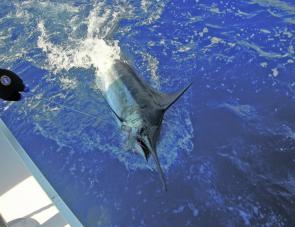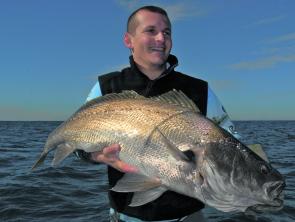May sees the southeasterlies of the warmer months ease off and the first westerlies start to blow. The current generally eases off a bit and the water temperatures start to drop.
This year has been quite erratic on the offshore grounds as far as pelagic fish activity is concerned. The two big rain events saw the dirty water extend well offshore and a lot of the marlin, mackerel and wahoo seemed to bypass the Gold Coast as they headed south in February and March. As the water cleared in late March the mackerel started to show up on the inshore grounds and quite a few blue marlin were caught out wide of the Continental Shelf.
May is a good month to chase blue marlin. These fish average about 150kg off the Gold Coast and quite a few are considerably bigger. They are a great challenge from a trailer boat. I generally put the lures in at the 50 fathom line and head out wider. Within a few kilometres east of the 50 fathom reef the depth rapidly increases to over 100m and most of the blue marlin we encounter are in water depths from 150-300m. In general we are about 50km offshore.
Stand up 37kg tackle is the best option, as 24kg gear can see you staring at the bottom of an empty spool as the blast off on strike is quite spectacular. Large skirted lures on 400-600lb leader are the most reliable method. I like Pakulas, Black Snack’s ‘Bad Benny’ and a few Hawaiian models such as Apollos and tubes.
Bycatch out wide includes yellowfin tuna, mahi mahi and wahoo. May sees quite a few big yellowfin caught in some seasons. A few striped marlin usually turn up in May as well as the odd medium-sized black.
In closer to shore Spanish and spotted mackerel should put in an appearance on Palm Beach, Mermaid Reefs, the Gravel Patch east of Burleigh Heads and the 20 fathom reef east of Southport. There should also be a few wahoo on the 20 fathom line, and some big ones will turn up at the Tweed Nine Mile.
High speed trolling using weighted skirted lures such as the locally made Hex Heads is a very effective method for wahoo and Spanish mackerel. The Nine Mile Reef is the best spot to try this method. These fish are capable of blistering strikes on lures travelling at 16 knots. Small live tuna slowly trolled around the back ledge of the Nine Mile is another deadly method but can attract a lot of sharks.
For bottom fishing the wider reefs start to fish well as the current drops off. Good pearl perch, juvenile snapper, amberjack and Samsonfish can be caught in May on the 50 fathom line and soft plastics, paternoster rigs and deep fished live baits are all very effective.
The reefs have had a bit of a break from anglers due to the summer current making the area almost impossible to fish, so early season fishing is often quite good, particularly for pearl perch.
The first of the winter westerlies generally start to blow in late May and the water temperature drops. This triggers the beginning of the spawning runs of bream, luderick and mullet. Fish numbers build up around the Seaway and Jumpinpin as these species get ready to spawn in June and July.
Prior to spawning, the fish feed very actively in order to build up condition, and there can be some great fishing for a wide range of species. Deep plastics and baits in the Seaway area and around the mouth of Swan Bay near Jumpinpin produce excellent quality bream at this time of year and the mulloway also become active chasing the build up of mullet in the entrances. While this activity is at its peak in June and July, May still sees a lot of fish caught.
Flathead become a lot more active as the water cools and while most of the fish are in the 40-60cm bracket they are usually in quite good numbers around the central part of the Broadwater between Crab Island through to Tipplers Passage. The water in this area has been very dirty over the past few months, which makes fishing with lures quite difficult, but if we have dry weather and light winds we should see the water clear up nicely.
The latest flathead lure getting good reviews is the Zerak Prawn. These lures are quite tough and the Kevlar strip between the sections makes for a very durable lure. Blades, Gulps and Z-Mann’s are all worth trying this month. Stick to water depths of about 1-3m for the best results and work areas where you see a bit of bait activity.
Mangrove jacks slow down a bit this month but a lot move into the Seaway area and the hole around the end of the north wall is a good spot to try with live bait. Cast your bait into the rocks and the wash and you will need heavy-handed tactics to get these jacks away from their rocky homes.
It is thought that the mangrove jack hold in the Seaway before moving to inshore reefs. Most of the Seaway fish are 50-60cm adults and it is at this size that they leave the estuary systems. Some of the biggest jacks in the Gold Coast region come from the offshore reefs such as Fidos and the Nine Mile. Fish well over 10kg turn up here at times.
Overall, May is a great month to fish the Gold Coast with a lot of options. Some of the summer species are present and the winter activity is just beginning. With a lot of calm still days there is great opportunity to try a wide range of options this month.
Reads: 2562
May is a great month to chase blue marlin. These fish average about 150kg off the Gold Coast and quite a few are considerably bigger.

Charles Britton with a mulloway. They will become active chasing the build up of mullet in the entrances.

Aykut Ahmet with a spotty; they can be found on Palm Beach, Mermaid Reefs, the Gravel Patch east of Burleigh Heads and the 20 fathom reef east of Southport.




